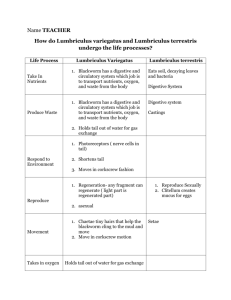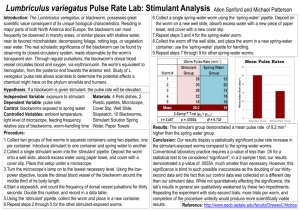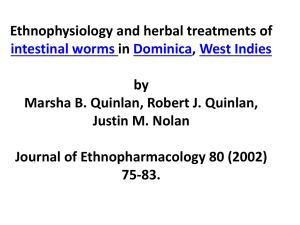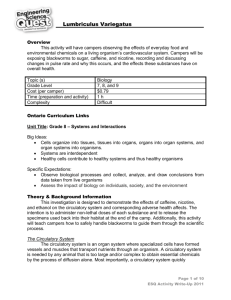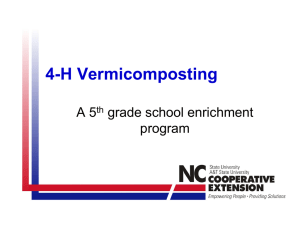7752.notes_-_blackworms
advertisement
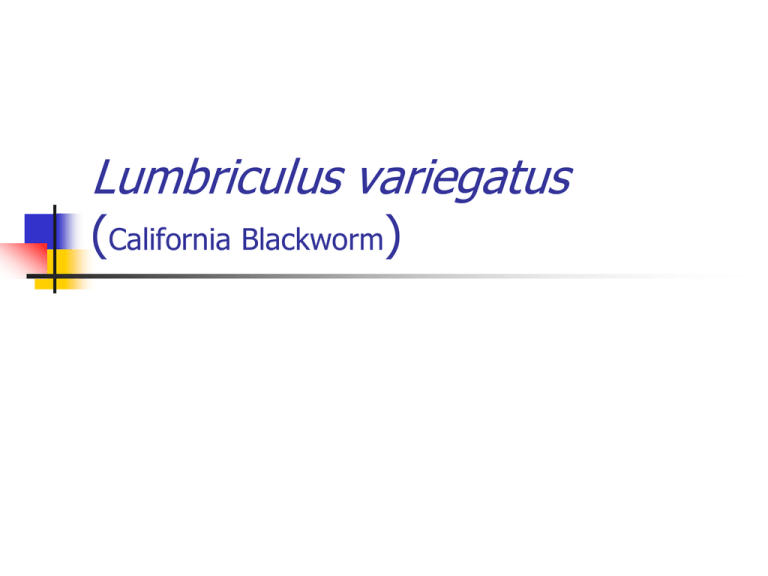
Lumbriculus variegatus (California Blackworm) Anticipation Guide Answer the following 3 questions in your science notebook 1. 2. 3. Describe some physical characteristics of worms. Where do worms live? What are some ways humans use worms? Open textbook to page 34 On your table is a handout with 12 questions from the assigned reading. Answer the questions using complete sentences in your science notebook. You may work QUIETLY as a group, but each person must have the answers written in their own notebook. Blackworm Notes Scientific Classification Kingdom: Animalia Phylum: Annelida Class: Oligochaeta Order: Lumbriculida Family: Lumbriculidae Genus: Lumbriculus Species: Variegatus Lumbriculus variegatus Scientific name Reasons for Classification Animalia = Multicellular, heterotrophic Annelida = segmented worm (over 17,000 species!!) Oligochaeta = few setae (chaetae) on outer body surface and lack parapodia (lateral outgrowths) Lumbriculida = live in freshwater environments (streams, lakes, marshes, wells, etc.) Lumbriculidae = **No additional features from the Order level of classification Lumbriculus = coloring/pigmentation, rapid escape reflex, photoreceptors, method of respiration Variegatus = one of three members of the genus; differences are minor and were thought to be a single species up until 2009. Blackworm Notes Habitat Reproduction Size muddy shores of lakes and ponds Asexual is always by fragmentation. Sexual is hermaphroditic (contain both male and female organs) but they cannot self-fertalize Max. length is approx. 10 cm in length, containing about 200-250 segments. Diameter is 1.5mm Blackworm Notes Movement Metabolism Growth & Development Swims in a corkscrew fashion Rapid escape reflex when threatened photoreceptors in their tail sense light, touch or vibration Blackworms keep their tails at the surface of the water at a 90 degree angle. The tail is exposed to air which allows for gas exchange (breathing) Uses head area to feed on decaying vegetation and microorganisms Head segments are darker and wider than the tail. Will regenerate when cut. Blackworm Notes Blackworm facts Do not have hearts blood is pumped by rhythmic contractions of the muscles pulse rate can be accelerated by caffeine or nicotine. can self-amputate in less than 1/5 of a sec. Anticipation Guide – Revisit Refer back to the original 3 questions, were your answers correct? Add to your answers if necessary. 1. 2. 3. Describe some physical characteristics of worms. Where do worms live? What are some ways humans use worms? Getting started!! For you table group come and get the following items: 1 petri dish lid one circular piece of filter paper Spring water to moisten the filter paper 1 Blackworm 1 drawing circle for each member of the group At your table, observe your blackworm with the hand lenses. Drawing a Blackworm Take your blackworm to the microscope and observe under LOW magnification (40x total) Create a scientific drawing of the blackworm, use the diagram on page 34 to help you label at least 3 features Tape the completed drawing into your comp. book Measuring a Blackworm Using your pipette and spring water, do the following: 1. 2. 3. 4. 5. 6. Carefully remove the worm, with some of the water, from the petri dish Slowly and carefully squirt the water with the worm onto a piece of notebook paper. Using the tip of the pipette, carefully draw the worm out to its full length. Use a ruler and measure the full length of the worm. Record the length next to your scientific drawing in your notebook. Carefully return the blackworm to the petri dish

